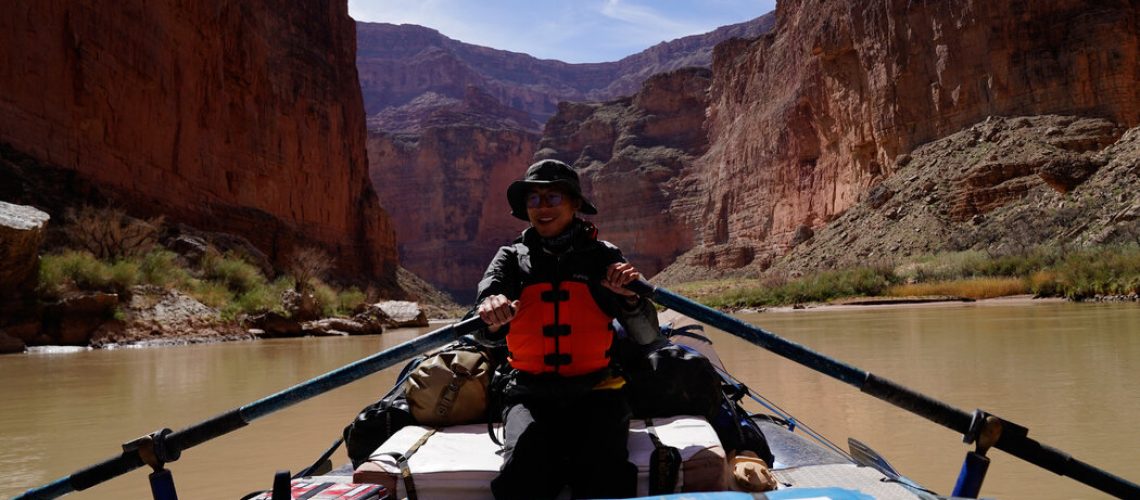Times Insider explains who we are and what we do and delivers behind-the-scenes insights into how our journalism comes together.
Raymond Zhong does not consider himself an adventurous person, but his reporting might suggest otherwise.
Mr. Zhong, who covers climate and the environment for The New York Times, has traveled to the top of a 13,800-foot volcano in Hawaii, trekked through a patch of forest to witness a prescribed fire burn in Northern California and rafted about 90 miles down the cold, unpredictable Colorado River in the Grand Canyon.
“There are so many people and places that are dealing with the effects of climate change,” Mr. Zhong said in a recent interview. “You have to be there in person to understand them.”
Here, Mr. Zhong shares what it’s like to report from unusual places, and the challenges of explaining the science of climate change. This interview has been edited.
How important is on-the-ground reporting to your coverage?
I’m based in New York City, which I wouldn’t say is the part of the country that’s experiencing climate change most viscerally. California, for example, with its wildfires and droughts, is much more on the front lines. Alaska is another example; the Arctic is warming faster than the rest of the world and permafrost and glaciers are melting. Alaska’s coasts are expected to experience more storms. Climate change is happening there, which affects the rest of the world.
How do you prepare for a reporting trip when it involves rafting 90 miles down the Colorado River?
I brought a camera, batteries, a GoPro, notebooks and a recorder. It was slightly more overhead than the scientists on the trip were used to. I also brought a solar-powered charger for my camera equipment and recorder, which proved useless. The walls of the Grand Canyon are so high that you only get enough sunlight to charge devices in the middle of the day.
How do you find article ideas?
I just follow the science. I often try to tag along with scientists on their journeys of discovery, and I keep track of what’s being published in scientific journals.
There’s a gap between how much scientists know about a subject and what is still a mystery and in need of additional inquiry; that’s always interesting to me and sometimes frustrating. My editors want clear answers, but scientists often have ambiguous ones. My job is to illuminate their process to whatever degree is scientifically justifiable and offer a version of the answer that is not completely hedged.
Is that challenging?
Yes. It’s tempting to say the Grand Canyon is going to be without water in 30 years. But it’s really not that simple. You still have wet and dry years and a lot of variability. Nature can be very resilient. The environment is fragile and humans can have a large influence on it, but there are ways in which nature resists change as well. I think that complexity can be frustrating. But the messiness of it, the fact that there are good and bad things that happen when humans alter their environments, is beautiful to explore.
You recently reported from beneath the ground in Chicago, where heat is causing the land to sink, weakening the foundations of buildings. What was that experience like?
Scientists in Chicago recently installed about 150 temperature sensors beneath the city to measure heat; I wanted to be there to see the sensors. A scientist was kind enough to let me follow him on a tour of these mucky, unpleasant places. We visited a parking garage, a commuter rail station, building basements and underground roadways.
As you can imagine, it was hot down there. We didn’t even go on a very hot day. These are places that some people depend on and use, but they are also places most people don’t want to think about. A lot of the issues happening underground are being swept under the rug.
You had one of the most interesting datelines I’ve seen in a while: “ABOARD A GULFSTREAM IV, over the Pacific.” How did that reporting begin?
Last year, I reported a lot on flood risks in California. I knew there were flights operated by the National Oceanic and Atmospheric Administration that fly over atmospheric rivers to help forecast weather. In January, a few days after I got back from Christmas vacation, when storms really picked up, I tried to get on one of the planes.
It came together really quickly; the scientists were happy to talk about their process. When storms form over the Pacific, scientists don’t have weather stations that tell them what is going on inside the storms. The only way to know how storms are moving is to drop instruments into them from a plane. It’s critical scientific work.
How do you distill complex science into comprehensible language?
Ultimately, I think a lot of what’s important to understand is not all that complicated. Writing, especially writing that involves science, shouldn’t make a reader feel confused. And if I can make a reader feel smarter for having read my story, I’ve done my job.





